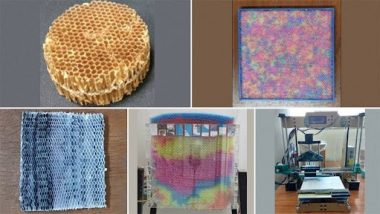An Indian researcher has fabricated paper honeycomb and stronger polymer honeycomb structure as sound-absorbing panels that dissipate acoustic energy to low-frequency ranges. The technology can be used in building acoustics and also as environmental noise control solution.
Many traditional materials have been found to be good at controlling higher frequencies. However, natural bee hives have been found to efficiently control high as well as low frequencies because of their geometry. It has been found from theoretical analysis and experimental investigations that this behaviour was owing to the conversion of acoustical energy into vibration energy. This vibration energy is dissipated in the form of heat due to wall damping property. Mimicking this property as an engineering solution could offer a cost-effective method for controlling noise pollution. Indian Researchers Work on Producing Hydrogen From Water Using Magnets.
Dr. B. Venkatesham and Dr. Surya, faculty at Mechanical and Aerospace Engineering Department at IIT Hyderabad, fabricated low thickness and strong acoustic panels mimicking this property using biomimetic design methodology. The design methodology involves understanding the physics of bee hive sample acoustic energy dissipation and then mimicking its design. The team developed a mathematical model and calculated optimized parameters, and then fabricated the test samples using systematic, controlled parameters. Subsequently, fabrication of a large sample was done. They have used two different approaches and their respective prototype machines with two different kinds of materials. One prototype is for paper honeycomb based on indexed -Honeycomb Before Expansion (HOBE) process, and another prototype machine is for polymer honeycomb structure based on hot wire technique.
The panels were made by slicing stacked extruded polypropene straws. The slicing process is done with the help of hot wire, which also bonds the straws together. The developed technology provides a mechanism of acoustic energy dissipation with lower thickness and higher specific strength of acoustic panels. A test facility to measure the absorption coefficient of large samples has also been established as part of this work.
This technology, supported by the Advanced Manufacturing Technologies programme of the Department of Science & Technology (DST), Government of India, is in the 6th stage of Technology Readiness Level, and Dr B. Venkatesham has allied with Eaton PVT Ltd, Maharashtra Industrial Development Corporation Kharadi Knowledge Park, Pune. He plans to further scale up the technology demonstration, develop a batch production machine for polymer materials, fabricate with newer alternative self-damping materials, and compliance with other safety requirements like flame retarding capacities, weather ability and so on. Dr Venkatesham says that it may create an opportunity to capture 15% of the traditional sound-absorbing acoustic material market based on the low-frequency applications.
(The above story first appeared on LatestLY on Sep 10, 2021 04:19 PM IST. For more news and updates on politics, world, sports, entertainment and lifestyle, log on to our website latestly.com).













 Quickly
Quickly











